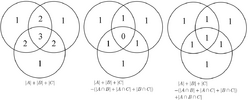Addition Principle
In combinatorics, the addition principle[1][2] or rule of sum[3][4][verification needed] is a basic counting principle. Stated simply, it is the intuitive idea that if we have A number of ways of doing something and B number of ways of doing another thing and we can not do both at the same time, then there are A + B ways to choose one of the actions.[3][1]

More formally, the rule of sum is a fact about set theory.[verification needed] It states that sum of the sizes of a finite collection of pairwise disjoint sets is the size of the union of these sets. That is, if [math]\displaystyle{ S_{1}, S_{2},..., S_{n} }[/math] are pairwise disjoint sets, then we have:[1][2] [math]\displaystyle{ |S_{1}|+|S_{2}|+\cdots+|S_{n}| = |S_{1} \cup S_{2} \cup \cdots \cup S_{n}|. }[/math] Similarly, for a given finite set S, and given another set A, if [math]\displaystyle{ A \subset S }[/math], then [math]\displaystyle{ |A^c| = |S| - |A| }[/math][5]
Simple example
A person has decided to shop at one store today, either in the north part of town or the south part of town. If they visit the north part of town, they will shop at either a mall, a furniture store, or a jewelry store (3 ways). If they visit the south part of town then they will shop at either a clothing store or a shoe store (2 ways).
Thus there are 3+2=5 possible shops the person could end up shopping at today.[citation needed]
Inclusion–exclusion principle

The inclusion–exclusion principle (also known as the sieve principle[1]) can be thought of as a generalization of the rule of sum in that it too enumerates the number of elements in the union of some sets (but does not require the sets to be disjoint). It states that if A1, ..., An are finite sets, then[1] [math]\displaystyle{ \left|\bigcup_{i=1}^n A_i\right| =\sum_{i=1}^n\left|A_i\right| -\sum_{i,j\,:\,1 \le i \lt j \le n}\left|A_i\cap A_j\right| + \sum_{i,j,k\,:\,1 \le i \lt j \lt k \le n}\left|A_i\cap A_j\cap A_k\right|-\ \cdots\ + \left(-1\right)^{n-1} \left|A_1\cap\cdots\cap A_n\right|. }[/math]
References
- ↑ 1.0 1.1 1.2 1.3 1.4 Biggs, Norman L. (2002). Discrete Mathematics. India: Oxford University Press. pp. 91, 112. ISBN 978-0-19-871369-2.
- ↑ 2.0 2.1 "enumerative combinatorics". 22 March 2013. https://planetmath.org/EnumerativeCombinatorics.
- ↑ 3.0 3.1 Leung, K. T.; Cheung, P. H. (1988-04-01) (in en). Fundamental Concepts of Mathematics. Hong Kong University Press. ISBN 978-962-209-181-8. https://books.google.com/books?id=QqgaZ799QGAC&q=%22rule+of+sum%22.
- ↑ Penner, R. C. (1999) (in en). Discrete Mathematics: Proof Techniques and Mathematical Structures. World Scientific. ISBN 978-981-02-4088-2. https://books.google.com/books?id=t5r79vZ9ogoC&dq=%22rule+of+sum%22+AND+%22mathematics%22&pg=PA342.
- ↑ Diedrichs, Danilo R. (2022). Transition to advanced mathematics. Stephen Lovett. Boca Raton, FL. p. 172. ISBN 978-1-003-04620-2. OCLC 1302331608. https://www.worldcat.org/oclc/1302331608.
See also
- Combinatorial principle
- Rule of product
- Inclusion–exclusion principle
fi:Todennäköisyysteoria#Tuloperiaate ja summaperiaate


